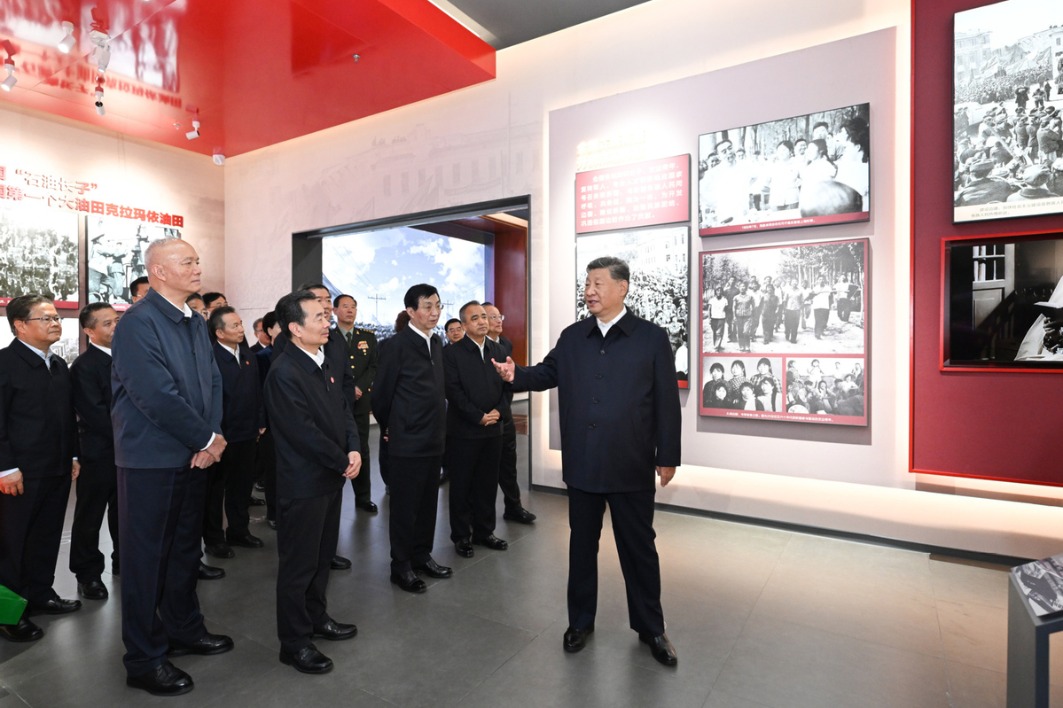Open gateway to the West


Leveraging its strategic location near Central Asia, Xinjiang is assuming an increasingly prominent role in the BRI
Seventy years since its establishment, the Xinjiang Uygur autonomous region has developed a role that extends far beyond its spectacular landscapes and rich ethnic traditions. Evolving from a remote frontier into a dynamic hub of openness and development, Xinjiang now embodies a pioneering model within the framework of the Belt and Road Initiative, which blends regional progress with global governance. Through innovative infrastructure, cross-border green energy cooperation, and shared advances in education and healthcare, the BRI offers developing nations a practical blueprint for shared growth and collective prosperity, built on consultation and collaboration.
Leveraging its strategic location near Central Asia, Xinjiang has evolved to be a dynamic hub bridging the East and the West within the BRI framework. Encompassing nearly one-sixth of China's total land area, the vast region shares borders with eight countries including Mongolia, Russia, Kazakhstan and Afghanistan, and boasts five main land ports and one major corridor as part of the Silk Road Economic Belt starting from Lianyungang port in East China's Jiangsu province and stretching to Amsterdam port in the Netherlands, connecting inner China with Central Asia and the wider Europe.
Among the signature projects of connectivity, the China-Kyrgyzstan-Uzbekistan Railway, currently under construction, is set to become a new key transport artery across Eurasia. Upon completion, it is projected to reduce the transportation distance across the three nations by about 900 kilometers, substantially lowering both costs and transit time. At the same time, the Kashgar Economic Development Zone was established as a center for cross-border e-commerce, generating tens of thousands of local jobs and showing strong potential to boost digital trade across neighboring countries.
Meanwhile, Xinjiang's green cooperation with the Central Asian countries exemplifies ecological conservation and sustainable development within the BRI framework. Built on technology transfer, collaborative projects and institutional synergy, the partnerships extend across renewable energy, ecological governance, green infrastructure and environmentally friendly trade. It not only tackles pressing issues such as energy shortages and ecological degradation in Central Asia, but also provides a Chinese model for sustainable growth that benefits the region and the world.
Xinjiang's green energy collaboration with Central Asian nations covers a broad spectrum of sectors, including photovoltaics, wind power, hydropower and energy storage. Local companies such as Goldwind and TBEA have developed and invested in multiple wind and solar power projects throughout the region. Key operational facilities such as the Turgusun Hydropower Station in Kazakhstan now produce around 80 million kilowatt-hours of clean energy annually, contributing significantly to carbon reduction efforts. These projects have not only generated substantial economic returns and created numerous jobs, but also promoted technology exchanges and delivered widespread social benefits. For instance, the Turgusun Hydropower Station has resolved electricity shortages in remote mountainous communities while employing more than 1,000 local workers. With ongoing infrastructure enhancements, including the China-Kyrgyzstan-Uzbekistan Railway and the grid loop in Northern Xinjiang, cross-border green energy cooperation is poised to expand, further advancing the region's progress toward carbon neutrality.
The partnership also extends to joint scientific surveys, knowledge sharing on sustainable agriculture and collaborative research on ecological restoration. For example, working alongside the International Innovation Center for the Aral Sea Basin, the Xinjiang Institute of Ecology and Geography has jointly implemented several key initiatives, including a demonstration zone for photovoltaic-coupled cotton cultivation with integrated water-fertilizer technology, an experimental site for vegetation recovery on salinized land, and a joint laboratory dedicated to soil and biological research. Furthermore, 80 automated stations for monitoring meteorology and water quality have been installed across the area. On saline-alkali land remediation, desertification control and water-efficient agriculture, the "technology+livelihoods" approach offers a replicable model for ecological recovery and sustainable growth in Central Asia, supporting the vision of the Green Silk Road and underscoring China's role in and commitment to global environmental governance.
In addition, Xinjiang has developed a multifaceted and comprehensive cooperation framework with Central Asian countries in education and healthcare. This collaboration spans various dimensions, including talent development, language promotion, joint scientific research and medical services. A prominent example is the Confucius Institute, jointly established in 2013 by Xinjiang Normal University and Osh State University in Kyrgyzstan, which became the first Confucius Institute in the Commonwealth of Independent States region to confer undergraduate degrees, with a rich variety of elective courses on offer in Chinese culture. Moreover, digital technologies, such as cloud computing and big data, are not only advancing distance education, but also being utilized to facilitate cross-border medical consultations through shared diagnostic resources. Under the BRI, Xinjiang has launched the construction of a Silk Road Economic Belt core area medical service center. By means of the Xinjiang cross-border medical platform, which leverages high-quality domestic resources, the center is to deliver standardized and interoperable telemedical services to hospitals in 10 neighboring countries. This initiative enhances the wellbeing of residents throughout Central Asia and further fosters the global sharing of medical technology, injecting significant impetus into the construction of a China-Central Asia community with a shared future.
As a multidimensional open gateway under the BRI, Xinjiang has developed strengths in commercial logistics, transport hubs, cultural and scientific education, and medical services. It has engaged in close, pragmatic cooperation with neighboring countries, transforming local specialty products, energy corridors, trade and digital technologies into vehicles for international cooperation. In these ways, Xinjiang has steadily and unassumingly contributed Eastern wisdom to bridging the development gap and addressing governance challenges within the BRI.
The author is a research fellow at the Institute of Russian, Eastern European and Central Asian Studies at the Chinese Academy of Social Sciences. The author contributed this article to China Watch, a think tank powered by China Daily.
The views do not necessarily reflect those of China Daily.
Contact the editor at editor@chinawatch.cn.
































